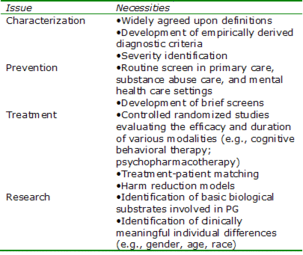During the past 30 years, gambling research has been prolific, with most of this research having been published during the last 10 to 15 years (Eber & Shaffer, 2000). There are, however, many fundamental areas that need further attention and investigation. Recently, Psychiatric Annals devoted an issue to the current status and future needs of treatment and research on pathological gambling. This week’s WAGER reviews an article from this issue (Potenza, 2002). Table 1 summarizes Potenza’s suggestions for the primary public health needs pertaining to gambling.
Table 1: Summary of needs identified by Potenza (2002)
The areas covered by Potenza (2002) are not inclusive; Potenza did not intend them to be. Other areas not mentioned in this review also might be important. For example, it might be beneficial to focus prevention efforts on settings other than healthcare facilities, such as schools. Research has suggested that youth gambling is problematic (Shaffer & Hall, 1996; Winters et al., 2002) and potentially related to faulty logic (Hardoon et al., 2001; Toneatto, 1999); early classroom interventions might ward off the development of problems later in life. Similarly, in addition to identifying treatments that are optimal for specific types of patients, researchers and treatment providers might also attempt to discern common treatment effects from specific treatment effects (see WAGER 6(50) for a review of common effects).
Potenza (2002) provides a brief overview of the current state of nosology, treatment, and research relating to pathological gambling. As with any area of research, his work reminds us that it is important to occasionally step back and take stock. This allows treatment providers and researchers to understand and evaluate their own work within a larger context. Ultimately, this will allow for a more comprehensive and integrated approached to the treatment of pathological gambling.
Comments on this article can be addressed to Debi LaPlante.
References
Eber, G., B., & Shaffer, H. J. (2000). Trends in bio-behavioral gambling studies research: quantifying citations. Journal of Gambling Studies, 16(4), 461-467.
Hardoon, K. K., Baboushkin, H. R., Derevensky, J. L., & Gupta, R. (2001). Underlying cognitions in the selection of lottery tickets. Journal of Clinical Psychology, 57(6), 749-763.
Potenza, M. N. (2002). A perspective on future directions in the prevention, treatment, and research of pathological gambling. Psychiatric Annals, 32(3), 203-207.
Shaffer, H. J., & Hall, M. H. (1996). Estimating the prevalence of adolescent gambling disorders: A quantitative synthesis and guide toward standard gambling nomenclature. Journal of Gambling Studies, 12(2), 193-214.
Toneatto, T. (1999). Cognitive psychopathology of problem gambling. Substance Use and Misuse, 34(11), 1593-1604.
Winters, K. C., Stinchfield, R., Botzet, A., & Anderson, N. (2002). A prospective study of youth gambling behavoirs. Psychology of Addictive Behaviors, 16(1), 3-9.





